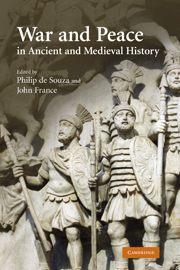Book contents
- Frontmatter
- Contents
- List of contributors
- Acknowledgements
- Note on abbreviations
- 1 Introduction
- 2 Making and breaking treaties in the Greek world
- 3 War, peace and diplomacy in Graeco-Persian relations from the sixth to the fourth century bc
- 4 Treaties, allies and the Roman conquest of Italy
- 5 Parta victoriis pax: Roman emperors as peacemakers
- 6 Treaty-making in Late Antiquity
- 7 Byzantine diplomacy: good faith, trust and co-operation in international relations in Late Antiquity
- 8 Treaties between Byzantium and the Islamic world
- 9 Siege conventions in Western Europe and the Latin East
- 10 Paying the Danegeld: Anglo-Saxon peacemaking with vikings
- 11 Peace among equals: war and treaties in twelfth-century Europe
- Bibliography
- Index
4 - Treaties, allies and the Roman conquest of Italy
Published online by Cambridge University Press: 09 August 2009
- Frontmatter
- Contents
- List of contributors
- Acknowledgements
- Note on abbreviations
- 1 Introduction
- 2 Making and breaking treaties in the Greek world
- 3 War, peace and diplomacy in Graeco-Persian relations from the sixth to the fourth century bc
- 4 Treaties, allies and the Roman conquest of Italy
- 5 Parta victoriis pax: Roman emperors as peacemakers
- 6 Treaty-making in Late Antiquity
- 7 Byzantine diplomacy: good faith, trust and co-operation in international relations in Late Antiquity
- 8 Treaties between Byzantium and the Islamic world
- 9 Siege conventions in Western Europe and the Latin East
- 10 Paying the Danegeld: Anglo-Saxon peacemaking with vikings
- 11 Peace among equals: war and treaties in twelfth-century Europe
- Bibliography
- Index
Summary
Introduction
This chapter is concerned with the use made by the Romans of treaties of alliance and other forms of association in the extension of their imperial power under the Republic. Although attention is paid to their overseas expansion, the chapter deals principally with the Roman conquest of Italy and seeks to challenge the generally accepted view that all the Romans' non-colonial Italian allies were bound to them by treaties. This is not a merely technical issue, but has far-reaching implications for our understanding both of the process of conquest and of Roman imperial structures.
Down to the mid fourth century bc the Romans were just one of the peoples of west central Italy, and their armies never ranged further than about fifty miles from their city. Their relations with their fellow Latins were governed by a treaty between Rome and the Latin League, said to have been concluded by the consul Spurius Cassius in 493. Dionysius of Halicarnassus (6.95) claims to report the treaty terms; if these are accurate, the treaty was an alliance on equal terms, but in the event the Romans were increasingly the dominant partner.
In 343 bc the Romans ventured further afield for the first time, to Campania, and became embroiled in the first of their wars against the Samnites, a powerful league of Oscan-speaking peoples in the southern central Apennines. This led to war between the Romans and the Latin League, aided by Campanians and others.
- Type
- Chapter
- Information
- War and Peace in Ancient and Medieval History , pp. 51 - 75Publisher: Cambridge University PressPrint publication year: 2008
- 14
- Cited by



